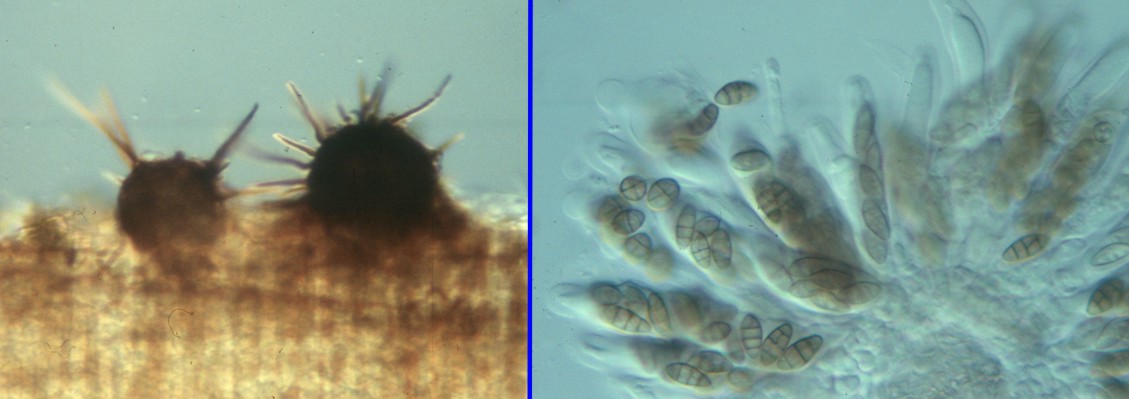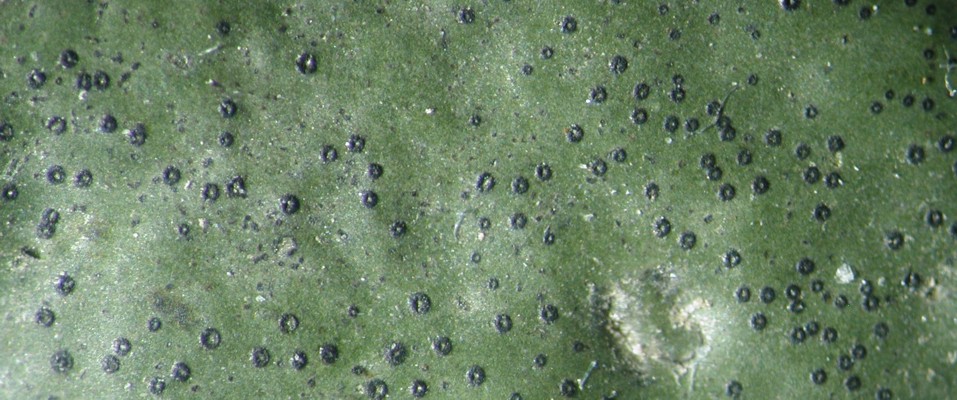Home >> Diversity and classification >> True fungi >> Dikarya >> Ascomycota >> Pyrenomycetes >> Eurotiomycetes
THE EUROTIOMYCETES
Of all groups of pyrenomycetes, the Eurotiomycetes are probably the most difficult to define, mainly because there is so little similarity among its major orders and families. Until mycologists started looking at DNA base sequences they simply didn't realize that these formed a group of related organisms. At present we still cannot present a good all-encompassing definition of the Eurotiomycetes and must fall back on a discussion of its components.
There are two subclasses of the Eurotiomycetes, the Chaetothyriomycetidae and the Eurotiomycetidae. The Chaetothyriomycetidae form typical perithecia and are appropriate to our discussion here. The Eurotiomycetidae all produce cleistothecia or other types of non-perithecia and are treated separately in the section covering the plectomycetes.
Subclass: Chaetothyriomycetidae
This subclass contains three orders, the Chaetothyriales, the Pyrenulales and the Verrucariales. The Chaetothyriales are mostly forms that resemble sooty moulds, occurring as saprotrophs on plant materials. The other two orders are almost entirely made up of lichen-forming fungi.
Order: Chaetothyriales
This is not a large order of fungi nor a particularly conspicuous one. The perithecia are small and often covered with sharp spines. The perithecial centrum contains fascicles of asci but no pseudoparaphyses. The asci may grow up among some periphysoids, but these are often not apparent. If you are unclear about these terms, review the section on terminology in the Discussion of the Dothideomycetes
Members of the family Chaetothyriaceae most occur in warm-temperate to tropical regions where there is abundant mosture for growth. They grow on stems and leaves of living trees where their perithecia occur in groups covered by a pale carpet of mycelium. This mycelial blanket is densest directly over the perithecia, forming a sort of loose stromatic covering. It is thought that most true sooty moulds are attracted to trees that harbour scale insects and are able to use the sugars these animals exude for their growth. However, members of the Chaetothyriaceae do not seem to be especially associated with insects and it has been suggested that they may live off exudates from the tree itself. They are not thought to be plant parasites.

The family Herptrichiellaceae is even smaller than the Chaetothyriaceae, containing fewer than 100 species. They are not unlike the Chaetothyriaceae in appearance and often grow on tree trunks. Their perithecia are minute and difficult to find without a good binocular dissecting microscope. The species of Capronia at right is typical of this family. The perithecia are spiny and are growing on the surface of a piece of wood. The asci are produced in a dense cluster that is completely without pseudoparaphyses. The dark septate ascospores are also typical.
The life histories of the Herpotrichiellaceae are difficult to visualize. Most are found on rotting wood or other materials that are crowded with other fungi. There is no indication that they are parasitic on other fungi nor is there any other obvious sign of what they are doing. They frequently produce simple anamorphs (Exophiala) that are abundant enough to make their dark colonies look wet or slimy, an attribute that has led to their common name "black yeasts". These black yeasts, usually without perithecia, are sometimes found in unusual places such as improperly sterilized steroid preparations, utility poles treated with creosote, sewage sludge and wood pulp samples. Their ability to digest various industrial chemicals has led to the suggestion that they could be used to filter out organic pollutants. Some cause disease of marine fish, indicating that they have a tolerance to salt water. They are also capable of causing mild to serious diseases in humans, some even leading to death.
Order: Pyrenulales and Verrucariales
These two orders of lichen-forming pyrenomycetes are diverse and abundant. It is interesting that these groups have been considered by nearly all mycologists as being quite unrelated to one another. Most authors have found sufficient differences in the appearances of their asci to declare one group to belong with the unitunicates and the other with the bitunicates. However some authors seemed unable to agree on which group had unitunicate asci and which had bitunicate ones! Of course this problem did not stem from the incompetence of the mycologists but from the fact that the fungi actually belonged with neither group.
Members of the two orders can be differentiated with certainty only at the microscopic level. The centrum of the Pyrenulales has pseudoparaphyses or perhaps even true paraphyses while that of the Verrucariales has neither pseudoparaphyses nor paraphyses but at most only periphysoids like members of the Chaetothyriales. At a less microscopic level we can generalize that the Pyrenulales are mostly warm-temperate to tropical lichens that grow on tree bark while the Verrucariales are often in temperate and cold climates and grow on rock. These are not absolutely firm rules, but they help

The picture above illustrates just how extensive some of these fungal colonies can be. It shows a section of shoreline at Seeley's Cove, New Brunswick that lies within the area inundated with seawater each day as the tide flows in. The light brown material at the bottom third of the picture is Ascophyllum nodosum, the most common large brown alga in this region. Above the Ascophyllum zone is a broad band of black. This black zone is a continuous growth of Hydropunctaria maura one of the most abundant perithecial lichens in the world. It is growing rather precisely in a region that is inundated with seawater on some days but not on others (the highest tides occur twice a month here). During storms it will receive abundant splash even if it is not covered. The rock above the Hydropunctaria zone is much whiter, indicating that H. maura is absent.

Another species, Verrucaria mucosa
, grows lower down in the tidal zone and may remain covered with water most of the time. In the picture at right the perithecia of V. mucosa are indicated by the black doughnut-shaped stromata scattered over the green thallus. The perithecia themselves are below the surface and the tops of their necks are covered by the black stromatic tissue with a hole in the centre leading into the ostiole. This picture was taken of material collected in late February when the asci were immature and the area above the ostiole still contained algae. Although many species of Verrucaria are aquatic, they must release their ascospores when they are exposed to the air. If a rock with V. mucosa is collected from the water and then suspended over a glass slide it will shoot its ascospores out onto it. However it will not shoot a second group of ascospores until it has been returned to the water for a few hours.The section on algal mutualisms discusses these lichens and their diverse habitats further. It also deals with the very interesting case of Mycophycias ascophylli, a member of the Verrucariales that lives in a mutualistic association with the brown seaweed Ascophyllum nodosum. Mycophycias ascophylli has all the attributes of other Verrucariales yet it does not form a conventional lichen thallus.